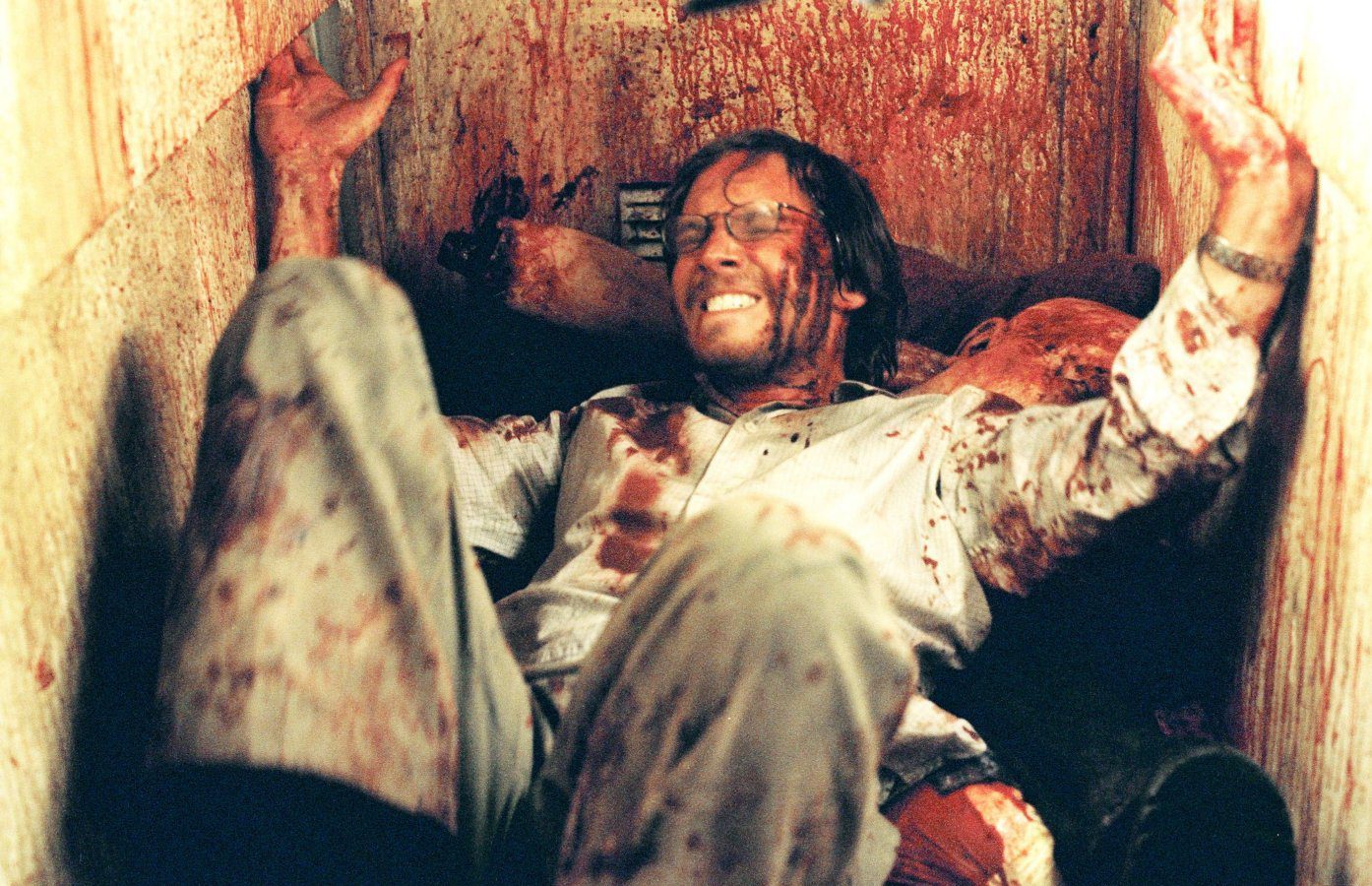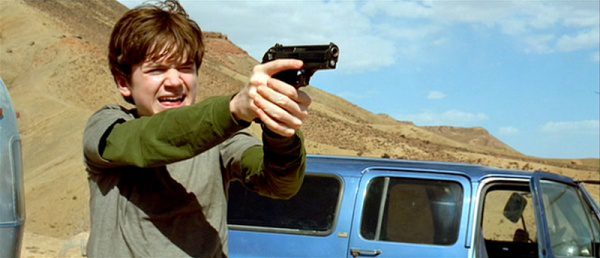“Ain’t nothin’ to see in the desert.”
It is so, so rare for a remake to be better than its source material (off the top of my head, I can think of only one, Zack Snyder’s 2004 Dawn of the Dead). Wes Craven’s 1977 The Hills Have Eyes was curiously sedate when it should have been grisly; that, coupled with the film’s relatively low profile at the time, made the idea of a remake an easier pill to swallow. The French director Alexandre Aja (High Tension) takes the premise and runs with it, and although the result isn’t perfect, this is the film that The Hills Have Eyes should always have been.
Aja doesn’t change the bones of the story, though; in a lot of ways, Hills is nearly a shot-for-shot remake of its progenitor (with the addition of a title card at the beginning which establishes that genetic mutation will play a much larger role in this film). The film opens on a desolate town in the middle of the New Mexico desert. Aja loves shooting these wide panoramic shots, inviting us to search the corners and borders of the screen for anyone lurking there. Very rarely do his shots get close and claustrophobic; he wants us to feel the enormity of the desert.
Fred, who runs the gas station (named Gas Haven – get it?), is skulking around town, shouting for an unnamed girl named Ruby. It’s a misstep to open with Fred – although it’s true to the format of Craven’s original – because the actor playing him, Tom Bower, gives the broadest performance in the film, and that includes the actors playing mutant cannibals. Bower is nearly incomprehensible at times, and his performance is in conversation with the character of Scooter in the Borderlands games (if you’re unfamiliar, look it up. That’s a great joke). Fred is in some kind of thrall to a man named Jupiter, and although he laments “I can’t do this anymore,” he’s still complicit in the fate of the Carter family, who stop by for gas (Bob, the patriarch, tells Fred, “Fill ‘er up and check the fluids,” his exact line from Craven’s film).
The Carter family (Bob and Ethel; their children, Bobby, Lynn, and Brenda; and Doug and Katy, Lynn’s husband and daughter) is better developed but a little less likable than the original incarnation. Bob (Ted Levine) is more gruff, more of a hardass, but Levine doesn’t play him as one-note. He almost sheepishly confides to Fred that they’re going to California so Bob can start a private security firm, and the way that Levine briefly looks at the ground when giving this admission tells us how insecure he is in his future. His relationship with his son-in-law, Doug (Aaron Stanford), is openly antagonistic this time around (“He’s a Democrat,” Bob quips. “He doesn’t believe in guns”). Bob isn’t in as much of The Hills Have Eyes as one would expect, but few actors make an impression as quickly as does Ted Levine – just try to forget his tense car ride with Leonardo DiCaprio in Shutter Island.
Things go south when the family drives over a row of spikes, causing Bob to crash the car. He walks back to Fred’s, while Doug continues on the supposed shortcut, each to find help. They don’t find help. Things go wrong immediately in their absence, and Aja relishes the chance to make Hills the visceral, ugly, nightmarish film it should have been. Everything in Craven’s original is amplified here. Fred isn’t killed by Jupiter; he shoots himself and his head practically detonates. Bob’s death, the best part of the first film, is deeply unsettling and nicely grisly. And Lizard and Pluto’s attack on the trailer is even more harrowing, with Aja refusing to back away from Brenda’s rape. The Hills Have Eyes is a slow burn, until it’s not, and his explosion of orgiastic violence nicely sets the stage for the finale.
With Bob, Ethel, and Lynn dead, and Katy taken by Mars, Doug, Bobby, and Brenda have to go on the offensive. They know that they’re outnumbered, and more than that, they don’t know these hills. When Doug picks up a walkie talkie and demands they return Katy, he’s answered by his baby’s cries, a cruel taunt. Stanford does good work with Doug’s mounting anguish and fury. His character seems modeled after Dustin Hoffman’s in Straw Dogs; when his glasses lens is broken, the image nicely recalls the poster for Peckinpah’s film. One narrative change that Aja made to this story was the focus on Doug, whereas in Craven’s film, Bobby slowly became the main character.
As Bobby, Robert Houston gave the best performance of the original, but Dan Byrd turns in solid work here as well. He’s in touch with Bobby’s impulsiveness – twice he runs off into the hills chasing the family’s dogs – but also his vulnerability. As Brenda, Lost‘s Emilie de Ravin gets little to do besides scream, but that’s unfortunately consistent with Craven’s film. She does get one great scene, though, where she collapses under the weight of trauma and violence.
Aja does violence spectacularly well. The most thrilling part of The Hills Have Eyes is an extended set piece wherein Doug fights Pluto, while trying to retrieve Katy. It’s grueling, and Stanford lets us see the physical and mental toll that it takes on Doug. The fight moves throughout the house; they maim each other, crash through walls, and when Doug finally kills Pluto it feels like the end of the ordeal that it is. The mythical Jupiter, however, barely makes an appearance (and when he does, he looks like Rob Zombie, which might be a coincidence). Neither film can decide what to do with Jupiter – Craven gave us too much, Aja gives us almost nothing at all. He’s a villain better suited for television.
In many ways, Craven’s film feels like it wanted to be ahead of its time, but wound up conforming to it; conversely, Aja’s feels precisely of its time (the mid-2000s saw the release of a lot of very gory horror films). I think Aja’s will stand the test of time better. It’s confrontational, mean, and at times a truly sensory experience. Its flaws notwithstanding, Aja’s is the better film.
10/1: Dawn of the Dead
10/2: Drag Me to Hell
10/3: Pet Sematary
10/4: The Descent
10/5: Repo! The Genetic Opera
10/6: Desierto
10/7: The Blair Witch Project
10/8: Blair Witch
10/9: The Texas Chainsaw Massacre
10/10: A Nightmare on Elm Street (2010)
10/11: Prince of Darkness
10/12: 30 Days of Night
10/13: Friday the 13th (2009)
10/14: Slither
10/15: Tremors
10/16: Pandorum
10/17: It Follows
10/18: A Girl Walks Home Alone at Night
10/19: Poltergeist
10/20: Paranormal Activity
10/21: Creepshow
10/22: VHS
10/23: Nosferatu the Vampyre
10/24: An American Werewolf in London
10/25: The Witch
10/26: The Rocky Horror Picture Show
10/27: Cronos
10/28: The Hills Have Eyes
10/29: The Hills Have Eyes (2006)
10/30: Tucker and Dale vs. Evil
10/31: Halloween (2007)



